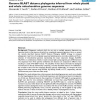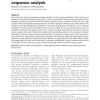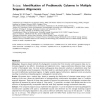53 search results - page 4 / 11 » Multiple sequence alignment accuracy and evolutionary distan... |
BMCBI
2005
13 years 8 months ago
2005
Background: Protein sequence alignments have become indispensable for virtually any evolutionary, structural or functional study involving proteins. Modern sequence search and com...
BMCBI
2004
13 years 8 months ago
2004
Background: In a previous paper, we introduced MUSCLE, a new program for creating multiple alignments of protein sequences, giving a brief summary of the algorithm and showing MUS...
BMCBI
2006
13 years 8 months ago
2006
Background: Phylogenetic methods which do not rely on multiple sequence alignments are important tools in inferring trees directly from completely sequenced genomes. Here, we exte...
BIB
2006
13 years 8 months ago
2006
One of the major goals of computational sequence analysis is to find sequence similarities, which could serve as evidence of structural and functional conservation, as well as of ...
ALMOB
2008
13 years 8 months ago
2008
Motivation: Sequence-based methods for phylogenetic reconstruction from (nucleic acid) sequence data are notoriously plagued by two effects: homoplasies and alignment errors. Larg...



